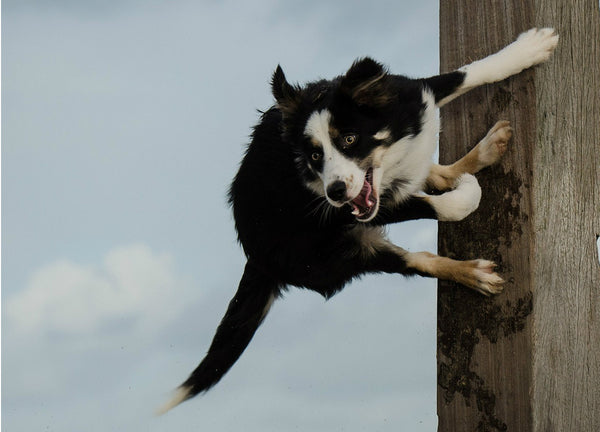But what does it all mean? Why do our furbuddies choose a particular method to get and hold our attention? Here are 12 reasons dogs howl, whine, and cry.
1. Stress

The number one reason dogs whine is because of stress. Suppose you’re in a training class and suddenly Buddy begins pacing, cowering, licking his lips or panting, drops his tail and quits responding to your cues. Then the whining starts. He’s telling you that he’s under too much stress and you need to change your training place or method. He’s reached his stress threshold.
Related Post: 10 Dog Breeds That Don't Tolerate Being Left Alone
2. Appeasement

When you’re out walking your furbaby and you come upon someone who is walking their furbaby, what does your dog do? If he’s whining and folding his ears back, tucking his tail in, rolling over on his back, crouching, and refuses to make eye contact, he lacks confidence. His whine is telling you that he does not feel safe, and he’s looking to you for assurance. If your efforts at socializing him fail, you may need to get professional help from a trainer to get him beyond his fear.
3. Separation anxiety
Related Post: 5 Tips to Help Your Dog’s Separation Anxiety
For many dogs, being left alone causes severe anxiety issues. Although some may act out by tearing the house apart, others may cry, whine, or howl, even for hours on end. Intervention may include slowly conditioning the dog to be left alone for longer and longer periods of time, and there are other ways to help your furbaby feel less anxious. A pet camera allows you to see and interact with your dog remotely when he becomes upset. Talking to your dog or tossing him a treat remotely is a great boon to those who must work and leave their dogs at home during the workday.
4. Pain

Interestingly enough, dogs with chronic pain rarely whine or cry because of it. However, acute pain, such as the sharp pain that accompanies rising for an arthritic dog, can certainly cause him to voice his discomfort. If your dog doesn’t have a condition that causes pain, yet he is whining, a trip to the vet is the best way to find out what’s going on.
5. Attention

Every dog lover who ever raised a puppy knows that when you first leave a puppy alone, he will cry. A natural part of learning to be a pet (perhaps the only one in his household) instead of part of a litter, puppies quickly learn that crying will bring attention. Older dogs learn this trick, too, crying for attention whenever they feel ignored.
6. Age-related dementia

As our dogs age, like humans, they sometimes develop cognitive problems. Confusion is very stressful to a dog, and often they will cry when they feel lost or afraid. Disorientation and dementia causes anxiety, which produces crying, whining, or even howling. See your vet for medications that can help.
Related Post: Top 4 Golden Retriever Health Problems!
7. Excitement

If your Labrador Retriever comes unglued, whining and barking when someone new comes in the door, he is probably also wiggling from his nose to the tip of his tail, which is wagging as though it will fall off. His communication is “I can’t control myself!” He needs some help to learn more moderate ways of greeting strange dogs or people. Training him to go to his mat when the doorbell rings will help him be calmer.
8. An invitation

In the wild, dogs howl to organize their pack. Howling helps the scouts locate the rest of the pack and return to them. In domestic dogs, howling may serve a similar purpose. If you’ve been gone all day, his howling hopes to bring you back home.
9. Setting boundaries

Sometimes, dogs howl to set up boundaries. Letting potential predators or even just trespassers know they have entered a dog’s territory is cause for a good, long howl. Many dogs bark when someone comes to the door or drives up in the driveway, but others howl for the same reason. It’s a form of communication that warns trespassers away.
10. Discovery

Especially with hunting breeds, dogs may howl to alert you to the fact that they have found something. For most hunting dogs, this is instinctual, but it can also be trained into them. Bloodhounds “sound” (howl) when they have picked up a track that they are trying to follow.
11. Trigger responses

It seems that dogs love to howl in response to certain triggers. Sirens, certain music, even someone singing can start a pup howling, looking for all the world like he wants to simply join in. Science hasn’t been able to account for why dogs will howl from certain triggers. Perhaps they just want to contribute to the celebration!
12. Speaking words?
Some people are convinced that their dog’s vocalizations are attempts to speak words. In fact, when sounds are selectively reinforced, they can seem to replicate human speech. It does, indeed, sound like they are saying words. It is unlikely that your furbaby knows what it means when he says “I love you,” but people encourage it nonetheless.
We’re learning more all the time about the way dogs think. Maybe, in time, we’ll be able to truly understand what it is our furbuddies are trying to say through their howls, whines, and cries.










